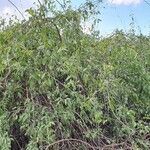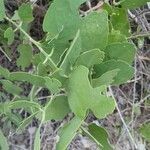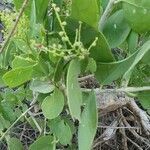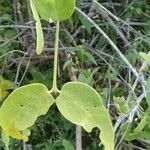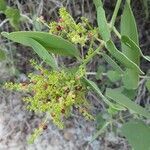An evergreen shrub or small tree. It grows 4-6 metres high. It has many branches forming a rambling habit. The stems are crooked and can grow along the ground. The branches are drooping and twisted. They are slender and greenish white. The bark is thin and rough. It is cream coloured. The leaves occur opposite one another along the stem. They are on short stalks. The leaves are smooth and fleshy but thick and leathery. They are greenish blue and have small stipules. The leaves are oval and 7 cm long by 3 cm wide. They end in a short stiff point. The flowers are yellow and small. many flowers occur together in a branched arrangement near the ends of branches. These flower arrangements are 5-8 cm long. The fruit is a round berry about 6 mm across. They are red when ripe. Seedless fruit can occur. The seedless fruit are dark red. The fruit are edible.
An evergreen shrub with grey or whitish stems forming tangled thickets, or a small tree, up to 2.7–6 m. tall, glabrous or pubescent.. Branches often pendulous, semiscandent, the flowering ones frequently hanging vertically for up to 1 m.. Leaves subsucculent; lamina coriaceous, lanceolate to elliptic, sometimes orbicular, 1.4–10.5 cm. long, 1.2–3(–7.5) cm. wide, rounded to subacute or acute at apex, mucronate, cuneate to subcordate at base; petiole 0.3–1.3(–2) cm. long.. Flowers small, greenish-white, in numerous lateral and terminal panicles, up to 10 cm. long, with slender racemose branches.. Drupes red or dark purple when ripe.. Fig. 3, p. 8.
Bushy, evergreen shrub, 0.6-5.0 m high. Leaves oblong-elliptic, narrowing slightly and equally to base and apex; glabrous or loosely pubescent. Terminal panicles overtopping leaves. Glands alternating with stamens inconspicuous. Flowers greenish yellow.
Leaves subsucculent; blades coriaceous, landeolate to elliptic, occasionally orbicular, 1–3–10 cm. long, 1–2–3 cm. wide, rounded to acute at apex, cuneate to subcordate at base.
Flowers small, greenish–white in lateral and terminal panicles up to 10 cm. long.
Branches long, often pendulous or semiscandent, glabrous or pubescent.
Much branched shrubs or small trees to 6 m. high, unarmed.
Drupes red or dark red purple when ripe.
A shrub or small tree, up to 30 ft. high
Fruits red or purplish when ripe.
Petals (1)–3 mm. long.
Leaves glaucous green
Flowers yellowish
